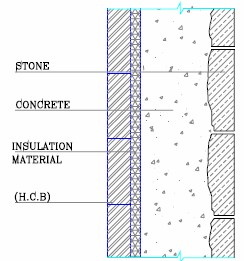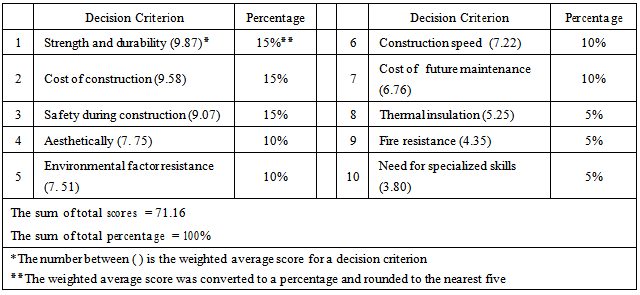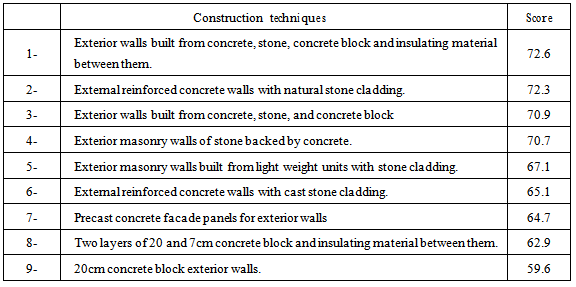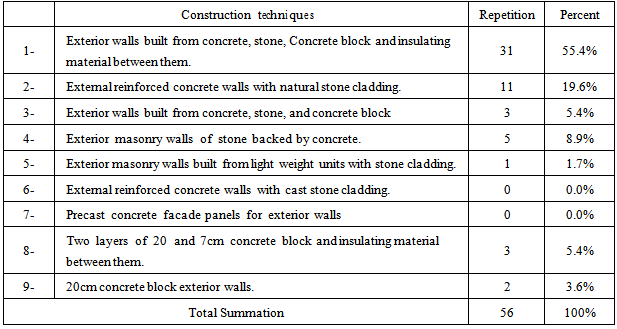-
Paper Information
- Paper Submission
-
Journal Information
- About This Journal
- Editorial Board
- Current Issue
- Archive
- Author Guidelines
- Contact Us
International Journal of Construction Engineering and Management
p-ISSN: 2326-1080 e-ISSN: 2326-1102
2014; 3(2): 43-46
doi:10.5923/j.ijcem.20140302.01
Decision Making in the Selection of the Exterior Walls Techniques in Affordable Housing Buildings in Palestine
Riyad Abdel-Karim Awad 1, Hanan Muhsen 2
1Civil Engineering Department, An-Najah National University, Nablus, Palestine
2Graduate School, An-Najah National University, Nablus, Palestine
Correspondence to: Riyad Abdel-Karim Awad , Civil Engineering Department, An-Najah National University, Nablus, Palestine.
| Email: |  |
Copyright © 2014 Scientific & Academic Publishing. All Rights Reserved.
Housing is considered the most important challenge facing the Palestinian National Authority, where the housing problem in Palestine is increasing day after day in light of the steady rise in population and returnees in the face of limited land and high prices of them, rising construction costs and relatively low income level. Success in providing affordable housing depends on several factors including the reduction of construction costs, which in turn depends on the construction techniques. Construction technique is a key tool to reduce the cost of the buildings but the reduction in cost should not be on the account of the efficiency of construction, durability, and resistance to natural and geological factors, and other than that the idea of getting the house of a low-cost, regardless of the expected age and quality of construction is a short sighted idea and a cheap solution in the present but a complex problem in the future. Therefore, there is a great need for a decision making process to select the optimum technique during the preliminary engineering study to reach to cut down the construction cost with the higher efficiency of the housing unit.
Keywords: Decision Making, Affordable Housing, Exterior Walls
Cite this paper: Riyad Abdel-Karim Awad , Hanan Muhsen , Decision Making in the Selection of the Exterior Walls Techniques in Affordable Housing Buildings in Palestine, International Journal of Construction Engineering and Management , Vol. 3 No. 2, 2014, pp. 43-46. doi: 10.5923/j.ijcem.20140302.01.
Article Outline
1. Introduction
- Housing is a major concern of every country, society, and household. For the country it has a political and economical effect, and plays a significant role in developing the economy and creating new jobs.The Palestinian National Authority is initiating a new endeavor to stimulate economic development and improve the housing stock through infrastructure development within the housing sector. There is high demand for housing in the Palestinian Territories (approximately 400,000 to 450,000 housing units in the next 10 years) and limited supply (about 16,000 units per year) according to the Ministry of Public Works and Housing. Purchasing housing is increasingly unaffordable due to high prices and low - per capita income. This research aims mainly to work to improve the level of housing projects in Palestine through the selection of the proper construction techniques in terms of cost of construction, strength and durability, aesthetics, etc. This research is conducted on the construction techniques in order to evaluate them and make decision in the selection of the proper construction techniques in order to obtain affordable quality housing.
2. Building and Construction Sector
- Building and construction constitutes the backbone of the various development policies which have either a negative or positive impact on the different development sectors. At the Arab level, the building and construction industry has achieved high development rates. Yet, in spite of such development, the economic and technical importance of this industry has not received the due attention due to the absence of any link within the Arab market, and the lack of integration and unity in the industry per se, being scattered in small country-based frameworks. Therefore; it can’t properly contribute to development unless it becomes an integrated system. The building and construction sector is vital to the economy, as it is diversified and covers several fields that are interrelated with the various sectors of economy. Building materials constitute the major elements in the buildings costs, ranging between 64% and 67% of the basic cost of any building. Thus the increase in its cost consequently leads to the increase in the cost of buildings. Building and construction technologies represent the effective solution to meet the ever increasing demand on quality, together with finalizing major projects on time, increasing the productivity of these materials, and maintaining high levels of vocational safety at the construction sites. The decision to use advanced building and construction technologies is affected by feasibility studies, which are manifested in the comparisons in the cost of employing highly skilled labor, modern technologies and equipment that require more or less intensive capital; particularly at the early stages of application of these technologies and the specific requirements of the project.
3. Building and Construction Sector in Palestine
- The building and construction industry is one of the leading economic sectors in Palestine, not only for its substantial contribution in the Palestinian Gross Domestic Product and in employment, but also for its strong interrelations with other economic activities. The construction of buildings, in particular, comprises a significant part of construction activities as a whole. Residential buildings make up the bulk of investments. Housing has been considered the most important challenge facing the Palestinian National Authority. Where the housing problem in Palestine is increasing day after day, Palestinian National Authority is trying to find solutions to this problem through the establishment of urban communities, but the availability of housing in it is inadequate in terms of quantity. Building materials industry in Palestinian Territories still doesn’t cover all the requirements of local market and imports make up the balance. In general, the main materials used in construction in Palestine are concrete, stone, hollow concrete blocks, steel, aluminum, wood and other complementary materials. These kinds of building materials can be used individually or together with each other to form the structure of buildings.Building techniques in Palestine are influenced by the materials available domestically as well as techniques in neighboring countries. The following construction techniques have been evaluated:1. External reinforced concrete walls with natural stone cladding.2. External reinforced concrete walls with cast stone cladding.3. Slab-beam-column system with exterior masonry walls of stone backed by concrete.4. Slab-beam-column system with exterior walls built from stone, concrete, and concrete blocks.5. Slab-beam-column system with exterior walls built from concrete, stone and concrete block and insulating material between them.6. Slab-beam-column system with exterior masonry walls built from light weight units with stone cladding.7. Slab-beam-column system with concrete blocks exterior walls.8. Slab-beam-column system with exterior masonry walls built from light weight units “ytong” with stone cladding.9. Slab-beam-column system using precast concrete facade panels for exterior walls.
4. Decision Making Process
- The decision making process which is followed in this study is the process of generating decision criteria, and identify the alternatives to select from. In this process the following table will be used to:1. Identify a decision the researcher wish to make and the alternatives considering.2. Identify the criteria that is considered important.3. Assign each criterion an importance score.4. Determine the extent to which each alternative possesses criterion.5. Multiply the criterion scores by the alternative scores to determine which alternative has the highest total points.
5. Methodology
- In this study, a questionnaire was prepared to determine the criteria that influence the decisions for selecting the proper construction technique and to determine their overall importance in the decision making process, and to evaluate the construction techniques by reference to these criteria. In this questionnaire, the construction techniques have been evaluated based on the weighted evaluation method by using a 10-point scale in making judgment in a decision criterion that influence the decisions for ranking and evaluating construction techniques. These criteria were obtained from the literature review, documentation of previously implemented construction projects, a survey and informal interviews with the people who are responsible for conducting construction projects. Table (1) shows the 10 decision criterions that were considered.
|
6. Data Analysis
- Based on questionnaire results analysis, Table (2) shows the degree of importance of the criterion that influences the decision for selecting the proper construction technique.
|
|
|
7. Conclusions
- Based on the results mentioned above regarding the selection of the proper construction technique for executing an affordable housing project of the nine surveyed techniques, one can say that there is a matching between the selection and the evaluation of these techniques if one looks to the selection of the proper technique, where most of the research sample (55.4%) selected the technique: Exterior walls built from concrete, stone, concrete block and insulating material between them, which has the highest total points (72.6) as the proper technique for executing an affordable housing project. This complies with the Jordanian Standards No. 851-1992 1nd the Palestinian Standard Institute specification No. 113-1999.Because an optimization must be reached between safety, serviceability, and economy to reach the minimum cost with the higher efficiency of the housing unit, the researcher started the thesis by introducing research objectives which can be summarized by review of construction techniques currently used in research environment (West Bank), then Developed a mechanism to evaluate these techniques and be judged by reference to decision criteria. Quantitative and qualitative researching approach has been used, and the data was collected using a questionnaire, 81 companies have been surveyed and the response rate was 69 per cent. Another data collection ways have been used also such as interviews, and personal observations.As a result the technique: Exterior walls built from concrete, cast stone, concrete block and insulating material, will enable cheaper housing construction (See Fig. 1).
 | Figure 1. A vertical Cross-Section in The Recommended System of The External Masonry Wall |
 Abstract
Abstract Reference
Reference Full-Text PDF
Full-Text PDF Full-text HTML
Full-text HTML


